

The beautiful Pillars of Creation, part of an active star-forming region within the Eagle Nebula. This image – from the Hubble Space Telescope in 2017 – is one of the most highly detailed to date. Image via NASA/ ESA/ Hubble Heritage Team (STScI/AURA).
The Eagle Nebula, also known as Messier 16 or M16, is one of the most amazing sights that can be seen in a large telescope. It’s the location of several famous structures including the stunning Pillars of Creation, an active star-forming region of gas and dust, depicted in the image above. The Eagle Nebula contains not only the Pillars of Creation but several other star-forming regions as well. It also has many emission nebulae, or clouds in space that shine with their own light. And it has some dark nebulae, which don’t shine themselves, but which can be seen because they obscure light from other sources.
The Eagle Nebula lies in the direction of the constellation Serpens the Serpent. It’s about 7,000 light-years away, and it’s visible in our sky at this time of year.
Take a look at the photos here, and delve deeper into this region of space, which is one of the most interesting and beautiful we know.

View larger. | The Eagle Nebula, aka M16. Photo via Martin MacPhee.
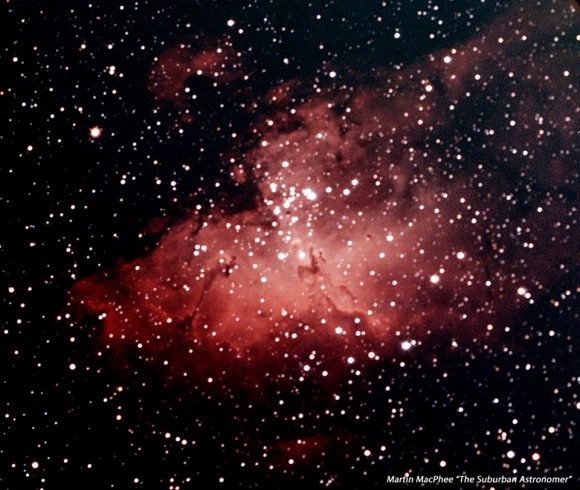
View larger. | A closer look at the Eagle Nebula. Image via Martin MacPhee.
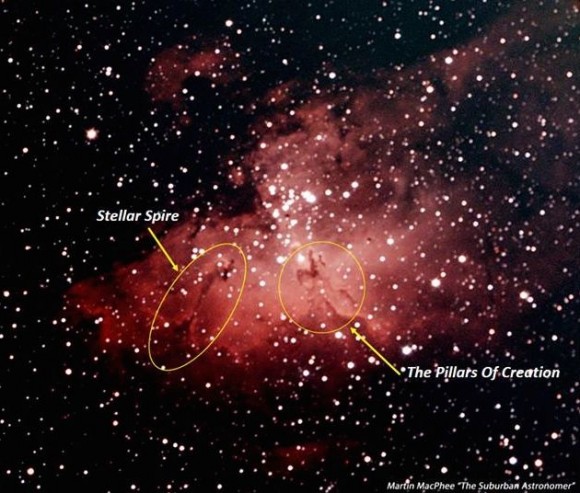
View larger. | Labelled map showing both the Pillars of Creation and the Stellar Spire within the Eagle Nebula. Image via Martin MacPhee.
In the late 18th century, when this object began to be catalogued by astronomers – discovered by Jean-Philippe de Cheseaux in 1745–46 – only the star cluster could be seen, and it was designated as M16 in Messier’s catalog of things not to be confused with comets. This star cluster later became known as the Snow Queen Nebula.
Even later, the advent of astrophotography revealed a large area of glowing hydrogen gas that was invisible to the unaided eye, and the nebula looked somewhat like an eagle with outstretched wings, giving rise to the current common name of Eagle Nebula.
As higher resolution photography and then digital photography began to reveal more and more features, particularly the dark patches (aka dark nebulae), many distinct features within the Eagle Nebula were given individual names. Today, the informal name of the Eagle Nebula is taken as referring to all of these in one collective designation.
Some of them are famous, and all are beautiful.
The Eagle Nebula suddenly burst upon the world’s collective consciousness in 1995, when the Hubble focused its attention on a dark nebula in the center of the Eagle, which you can see in the (updated) photo at the top of this post.

As viewed from the Northern Hemisphere, you’ll find the Eagle Nebula, or M16, above and to the left of the famous Teapot asterism of the constellation Sagittarius. Image via Tammy Plotner/ Universe Today.
The mesmerizing dark protrusions of dense gas were found to be the site of the formation of new stars and solar systems, and the resulting photograph became known as the Pillars of Creation and gave most people their first view of newly born stars and solar systems at the dawn of their creation. The Pillars of Creation are immense, about four to five light-years tall. The Eagle Nebula itself spans about 70 by 55 light-years.
Similar areas, such as the Stellar Spire on the left side of the Eagle, are also forming new stars, through a combination of processes. The cold, mostly hydrogen, gas of the nebula has already fueled the formation of a series of young, hot stars. As the gas continues to collapse under its own gravity into the dark forms we see, new stars and solar systems are formed and continue to grow as they attract more and more gas to them. However, the intense light pressure from the new stars that have formed and their solar winds are eroding away the dense, cold gas pockets, diminishing new star formation and dispersing the nebulae.
At the same time however, the shock waves where the light and solar wind impacts the cold gas, heat and compress some of the cold gasses at the same time, resulting in a new set of star forming environments.
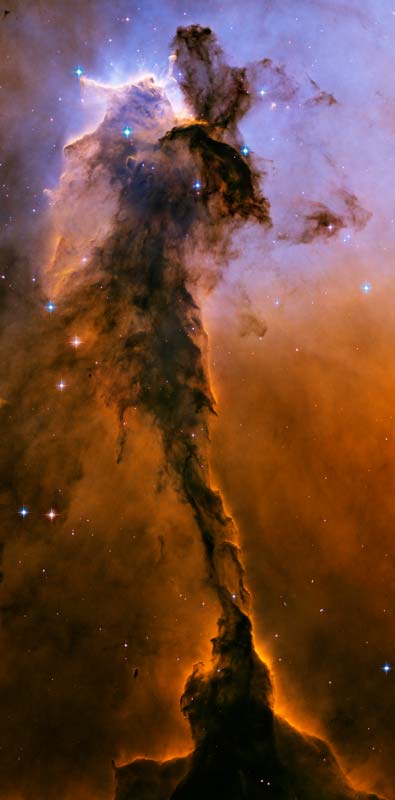
The Stellar Spire, also located in the Eagle Nebula, as seen by the Hubble Space Telescope. The “spire” is about 9.5 light-years long. Image via NASA/ ESA/ The Hubble Heritage Team (STScI/AURA)/ Wikipedia.
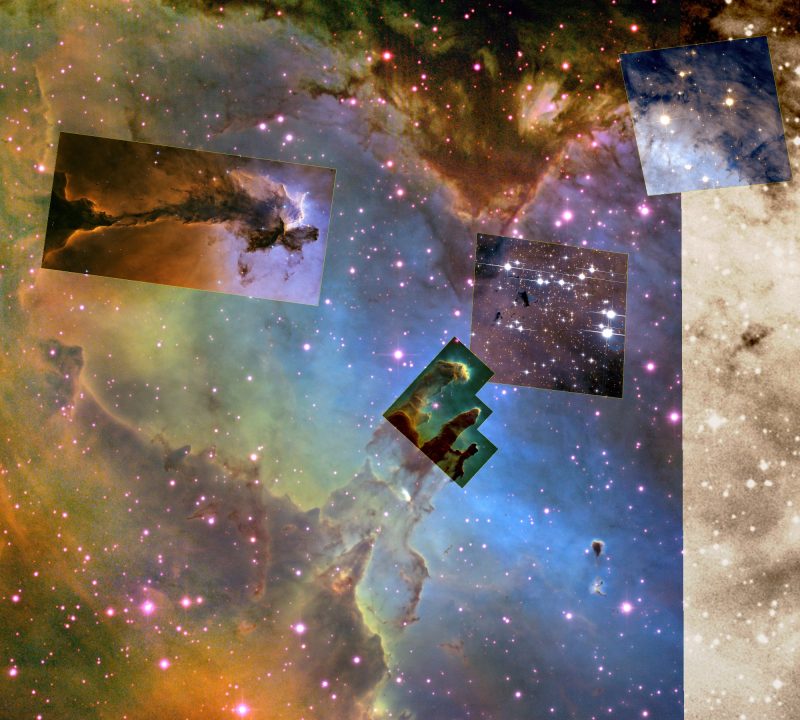
These are some of the best well-known areas inside the Eagle Nebula. Image via NASA/ STScI/ WikiSky/ Wikipedia.
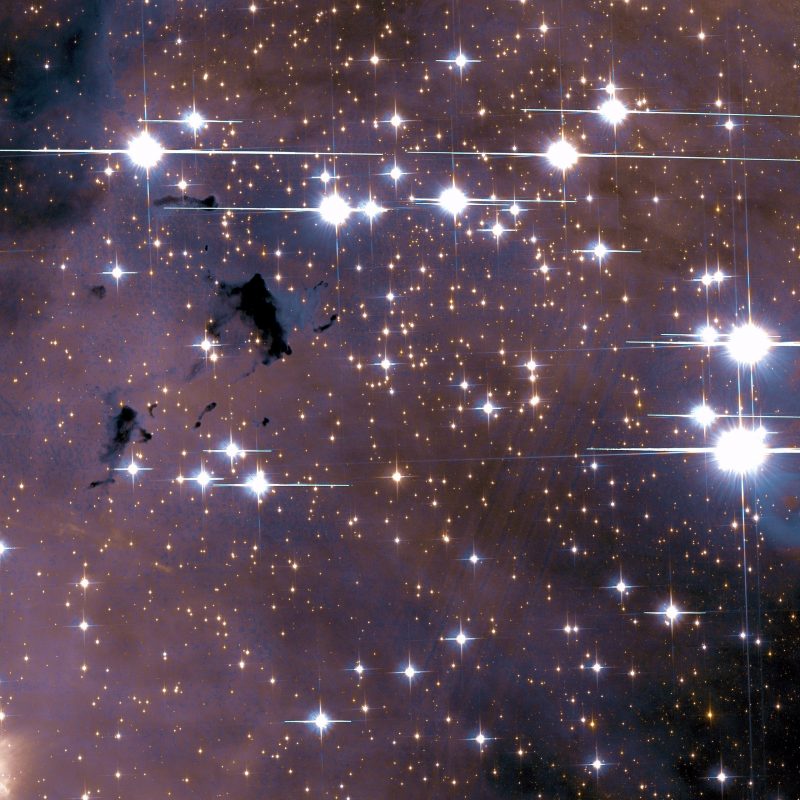
Closer view of an open star cluster in the nebula (highlighted in image above this one). Image via NASA/ STScI/ WikiSky/ Wikipedia.
As EarthSky writer Martin MacPhee recounted some years ago:
I am very pleased I can see these structures in my ‘scope, which is only 8″ in diameter, especially given that they are located around 7,000 light-years away, and the Stellar Spire is roughly 9.5 light-years (~ 9 trillion kilometers) tall – about twice the diameter of our solar system. In seeing them from my driveway in the heavily light-polluted Maryland suburbs of Washington D.C., I’m doing very well. And for approximately $10,000,000,000 less than the Hubble telescope cost, which makes my wife very happy too!
And there’s more. In 2015, some scientists suggested that the Pillars and Spire were likely already gone, victims of a massive shock wave from a supernova explosion that happened 6,000 years ago and destroyed them. The idea was that its light had already gone past us, but the slower-moving shock waves would have taken thousands of years more to sweep through the Eagle Nebula, destroying the delicate structures we find so entrancing.
Then, in 2018, that view changed again. Another update suggested the data suggesting destruction were in error. Instead, it seems, these structures – the Pillars and Spire – likely will remain for hundreds of thousands of years more before slowly evaporating away.
Bottom line: The Eagle Nebula, or M16, is home to at least two famous and awe-inspiring cosmic structures: the Pillars of Creation and the Stellar Spire.
Read about how the Pillars of Creation were created
from EarthSky https://ift.tt/3g4WrEB


The beautiful Pillars of Creation, part of an active star-forming region within the Eagle Nebula. This image – from the Hubble Space Telescope in 2017 – is one of the most highly detailed to date. Image via NASA/ ESA/ Hubble Heritage Team (STScI/AURA).
The Eagle Nebula, also known as Messier 16 or M16, is one of the most amazing sights that can be seen in a large telescope. It’s the location of several famous structures including the stunning Pillars of Creation, an active star-forming region of gas and dust, depicted in the image above. The Eagle Nebula contains not only the Pillars of Creation but several other star-forming regions as well. It also has many emission nebulae, or clouds in space that shine with their own light. And it has some dark nebulae, which don’t shine themselves, but which can be seen because they obscure light from other sources.
The Eagle Nebula lies in the direction of the constellation Serpens the Serpent. It’s about 7,000 light-years away, and it’s visible in our sky at this time of year.
Take a look at the photos here, and delve deeper into this region of space, which is one of the most interesting and beautiful we know.

View larger. | The Eagle Nebula, aka M16. Photo via Martin MacPhee.

View larger. | A closer look at the Eagle Nebula. Image via Martin MacPhee.

View larger. | Labelled map showing both the Pillars of Creation and the Stellar Spire within the Eagle Nebula. Image via Martin MacPhee.
In the late 18th century, when this object began to be catalogued by astronomers – discovered by Jean-Philippe de Cheseaux in 1745–46 – only the star cluster could be seen, and it was designated as M16 in Messier’s catalog of things not to be confused with comets. This star cluster later became known as the Snow Queen Nebula.
Even later, the advent of astrophotography revealed a large area of glowing hydrogen gas that was invisible to the unaided eye, and the nebula looked somewhat like an eagle with outstretched wings, giving rise to the current common name of Eagle Nebula.
As higher resolution photography and then digital photography began to reveal more and more features, particularly the dark patches (aka dark nebulae), many distinct features within the Eagle Nebula were given individual names. Today, the informal name of the Eagle Nebula is taken as referring to all of these in one collective designation.
Some of them are famous, and all are beautiful.
The Eagle Nebula suddenly burst upon the world’s collective consciousness in 1995, when the Hubble focused its attention on a dark nebula in the center of the Eagle, which you can see in the (updated) photo at the top of this post.

As viewed from the Northern Hemisphere, you’ll find the Eagle Nebula, or M16, above and to the left of the famous Teapot asterism of the constellation Sagittarius. Image via Tammy Plotner/ Universe Today.
The mesmerizing dark protrusions of dense gas were found to be the site of the formation of new stars and solar systems, and the resulting photograph became known as the Pillars of Creation and gave most people their first view of newly born stars and solar systems at the dawn of their creation. The Pillars of Creation are immense, about four to five light-years tall. The Eagle Nebula itself spans about 70 by 55 light-years.
Similar areas, such as the Stellar Spire on the left side of the Eagle, are also forming new stars, through a combination of processes. The cold, mostly hydrogen, gas of the nebula has already fueled the formation of a series of young, hot stars. As the gas continues to collapse under its own gravity into the dark forms we see, new stars and solar systems are formed and continue to grow as they attract more and more gas to them. However, the intense light pressure from the new stars that have formed and their solar winds are eroding away the dense, cold gas pockets, diminishing new star formation and dispersing the nebulae.
At the same time however, the shock waves where the light and solar wind impacts the cold gas, heat and compress some of the cold gasses at the same time, resulting in a new set of star forming environments.

The Stellar Spire, also located in the Eagle Nebula, as seen by the Hubble Space Telescope. The “spire” is about 9.5 light-years long. Image via NASA/ ESA/ The Hubble Heritage Team (STScI/AURA)/ Wikipedia.

These are some of the best well-known areas inside the Eagle Nebula. Image via NASA/ STScI/ WikiSky/ Wikipedia.

Closer view of an open star cluster in the nebula (highlighted in image above this one). Image via NASA/ STScI/ WikiSky/ Wikipedia.
As EarthSky writer Martin MacPhee recounted some years ago:
I am very pleased I can see these structures in my ‘scope, which is only 8″ in diameter, especially given that they are located around 7,000 light-years away, and the Stellar Spire is roughly 9.5 light-years (~ 9 trillion kilometers) tall – about twice the diameter of our solar system. In seeing them from my driveway in the heavily light-polluted Maryland suburbs of Washington D.C., I’m doing very well. And for approximately $10,000,000,000 less than the Hubble telescope cost, which makes my wife very happy too!
And there’s more. In 2015, some scientists suggested that the Pillars and Spire were likely already gone, victims of a massive shock wave from a supernova explosion that happened 6,000 years ago and destroyed them. The idea was that its light had already gone past us, but the slower-moving shock waves would have taken thousands of years more to sweep through the Eagle Nebula, destroying the delicate structures we find so entrancing.
Then, in 2018, that view changed again. Another update suggested the data suggesting destruction were in error. Instead, it seems, these structures – the Pillars and Spire – likely will remain for hundreds of thousands of years more before slowly evaporating away.
Bottom line: The Eagle Nebula, or M16, is home to at least two famous and awe-inspiring cosmic structures: the Pillars of Creation and the Stellar Spire.
Read about how the Pillars of Creation were created
from EarthSky https://ift.tt/3g4WrEB

Aucun commentaire:
Enregistrer un commentaire